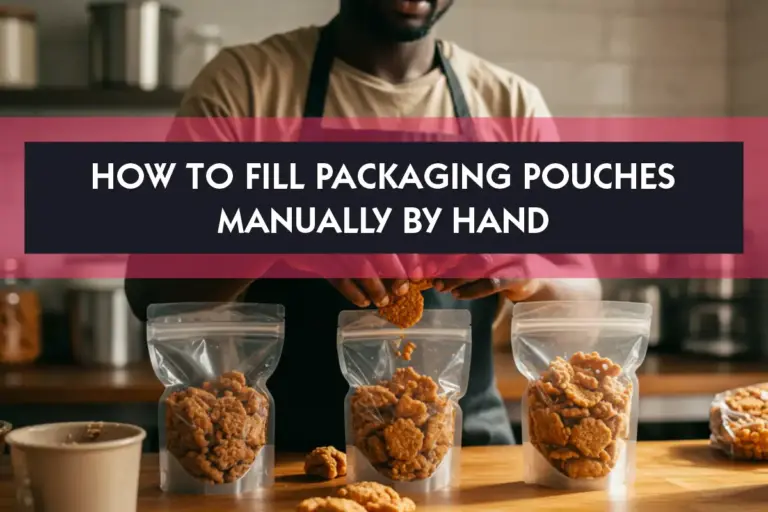When you are running a small business or starting out from home, packaging your product properly is very important. Whether you’re selling food items like chin chin, garri, groundnuts, or even liquid products like zobo and palm oil, using the right pouch can make your business look neat and professional. But many small business owners don’t have machines yet. So, they have to fill their packaging pouches by hand. This can sound difficult at first, but it’s actually simple when you know the steps and follow them properly.
By the time you are done reading this, you will have learnt and understood the step-by-step way to fill packaging pouches manually by hand. You don’t need any expensive tools. Just a clean space, your product, the right pouches, and a few simple tools you may already have at home. We will explain everything clearly so you can do it well, avoid mistakes, and make your packaging neat and attractive.
Table of Contents
ToggleThings You Need To Fill Pouches By Hand
Before you start, make sure you have everything you need. Here is a list of basic things:
1. Your product (dry or liquid)
2. The right pouch for your product
3. A clean table or working surface
4. A small scoop, spoon, or funnel
5. A small bowl to hold the product before pouring
6. A band sealer or impulse (for sealing the pouch)
7. A weighing scale (optional but useful)
8. Gloves (if you’re handling food)
9. Tissue or clean cloth (to clean spills)
Step-by-Step Guide to Filling Dry Products Manually
Dry products include items like rice, beans, chin chin, flour, gari, plantain chips, and more.
Step 1: Prepare Your Work Area
Make sure the place where you will be working is clean. Clean the table with a dry cloth. Keep your tools and pouches near you. Make sure your hands are clean or wear gloves if necessary.
Step 2: Set Up the Product
Pour the dry product into a clean bowl. Wear a glove and use a scoop or spoon to avoid touching the product directly with your hands.
Step 3: Open the Pouch
Hold the pouch with one hand and open the mouth of the pouch wide. Some pouches come with a zip lock, while others are plain. If it’s plain, just open it carefully so the shape doesn’t bend.
Step 4: Fill the Pouch
Use your scoop or spoon to gently pour the product inside the pouch. Don’t rush. If the pouch is small, use a funnel to make it easier. Fill to the level you want, but leave enough space at the top for sealing. Most people leave about 1 inch or 2 inches empty space.
Want To Print Something?
Step 5: Remove Air and Adjust
Gently tap the bottom of the pouch on the table to settle the product inside. If there’s too much air, press gently to push it out. The pouch should not look swollen.
Step 6: Seal the Pouch
If you’re using a zip-lock pouch, you can use the ziplock before sealing and then use either your band or impulse sealer to seal the top of the pouch. Press the pouch firmly under the sealer and hold for about 2 to 3 seconds (depending on your sealer). Then release.
Step 7: Check the Seal
Check if the seal is strong. Gently press the sides of the pouch. If it opens, the seal is not tight. Seal again if needed.
Step 8: Clean the Outside
If anything spills on the pouch, clean it with a tissue or cloth. Make sure it looks neat.
Step-by-Step Guide to Filling Liquid Products Manually
Liquid products include items like zobo, palm oil, groundnut oil, honey, etc.
Step 1: Prepare Your Work Area
For liquids, make sure the space is very clean and dry. Keep tissue close in case of spills. You don’t want to make the pouch slippery.
Step 2: Get the Right Pouch
Use pouches that are strong and made for liquids. Most liquid pouches have a spout or are made with thick plastic. This helps avoid leakage.
Step 3: Use a Funnel
A funnel is very important for filling liquids. It helps you pour with minimal or no spilling. Place the funnel inside the pouch before you pour anything.
Step 4: Pour the Liquid
Pour your liquid slowly through the funnel into the pouch. Don’t fill to the top. Leave about 1 to 2 inches of space for sealing. If you fill it too much, it may leak during sealing.
Step 5: Remove Air and Clean
After pouring, gently press the pouch to remove extra air. Then wipe the top and outside of the pouch to make sure there’s no oil or liquid on it. This helps the seal to stay strong.
Want To Print Something?
Step 6: Seal the Pouch
Use your band sealer or impulse sealer to seal the pouch and make sure the top of the pouch is dry. Press for 2 to 3 seconds. If you’re using a spout pouch, you can just screw the cap tightly after filling.
Step 7: Check for Leaks
Turn the pouch upside down slightly to check for leaks. If there’s leakage, seal again or wipe and try once more.
What To Do If You Don’t Have a Hand Sealer
If you don’t have a hand sealer, you can use an iron, but you must be careful. Wrap the mouth of the pouch with baking paper or brown paper and press gently with the warm iron for a few seconds. Make sure the iron is not too hot. Then check for leakage. This is just a temporary method, but it works.
Filling packaging pouches manually by hand is a skill every small business owner can learn. It doesn’t require big machines or expensive tools. Just a clean space, your product, a few simple tools, and careful hands. When you do it properly, your product looks neat, customers are happy, and your business grows.
As a small business owner, don’t be afraid to start small. You don’t need to wait until you buy a machine. Start with your hands and a pressing iron. Fill neatly. Seal properly. Package well. Over time, your speed will improve, and your business will grow. This method has helped many people, and it can help you too.




